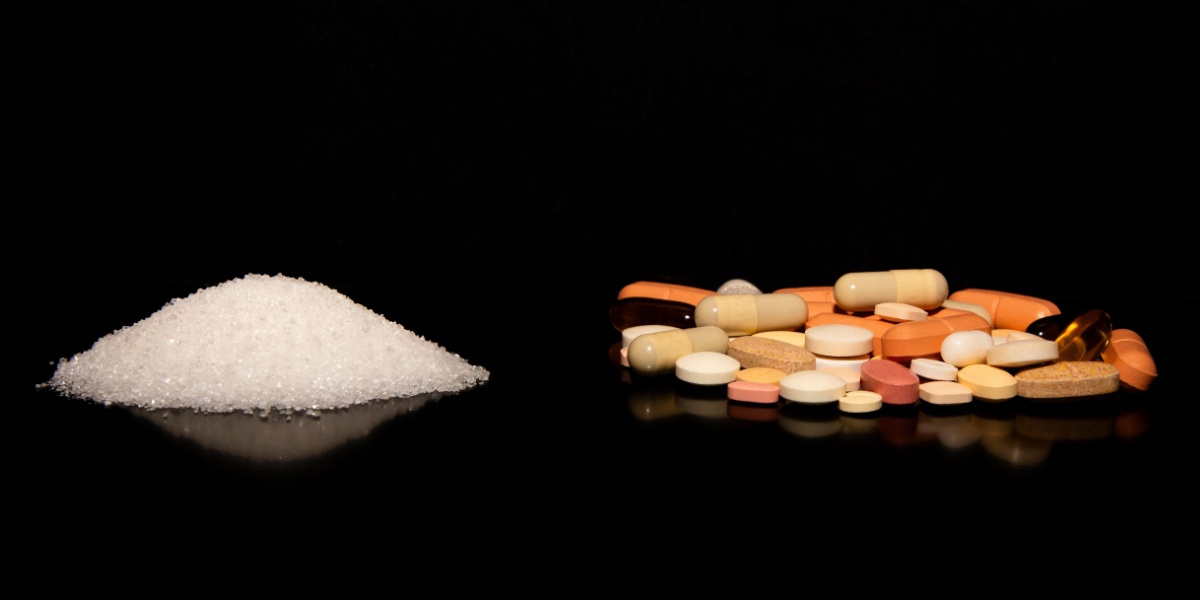Shows like Breaking Bad have brought meth use into the public consciousness. However, with the increased attention given to the use of this illicit drug, many misconceptions have developed alongside it.
One such area of misinformation is about the relationship between methamphetamine (meth) and the prescription drug Adderall (amphetamine-dextroamphetamine). This article will address the relationship between meth and Adderall, dispelling common myths along the way.
This information is not intended to replace professional medical advice. If you are concerned about Adderall or methamphetamine use, seek support from your healthcare provider.
- Adderall and meth are both stimulant drugs. While Adderall is commonly prescribed to treat ADHD and narcolepsy, methamphetamine is rarely used medically and is often misused illicitly.
- When used as prescribed, Adderall is safe with controlled side effects. This is in contrast to meth use, which can cause severe health impacts and even death.
- While Adderall and meth can each be addictive, meth has a much greater abuse potential. It is never too early to seek professional help for stimulant addiction.

Understanding Adderall and Methamphetamine
Adderall and methamphetamine share chemical similarities, as both are stimulant drugs that affect dopamine and norepinephrine levels in the brain. This resemblance, along with their overlapping side effects—such as increased alertness, reduced appetite, and elevated heart rate—has led to misconceptions that they are essentially the same drug. Additionally, both are classified as Schedule II controlled substances, reinforcing the confusion.
However, despite these similarities, there are critical differences between the two. Adderall is a prescription medication used to treat ADHD and narcolepsy under medical supervision, while methamphetamine—especially in its illicit form—is far more potent, addictive, and dangerous.
Comparing Adderall and methamphetamine is best done by first looking at each of the drugs separately.
What is Adderall?
Adderall is the brand name for a medication made up of a combination of amphetamine salts (also referred to as dextroamphetamine-amphetamine). In the U.S., Adderall is prescribed to treat attention-deficit/hyperactivity disorder (ADHD) and narcolepsy. [1]
Adderall is a stimulant drug that triggers dopamine and norepinephrine receptors in the brain. When treating ADHD, the goal of prescribing regular, low doses of a stimulant medication is to desensitize and stabilize these receptors, leading to improved focus and reduced impulsivity. [1]
What is Methamphetamine?
Methamphetamine (otherwise known as meth or crystal meth) is a powerful stimulant drug commonly abused for recreational purposes. Methamphetamine pharmaceuticals are sometimes prescribed in low doses to treat ADHD when other medications (such as Adderall) are unsuitable or have not worked. [2]
Meth has a similar effect to Adderall on the brain but is much more potent and is associated with more severe side effects. It is for this reason that meth is considered highly addictive and has a significant potential for abuse. [2]
Meth vs. Adderall: Key differences
It’s time to take a look at some of the key differences between meth and Adderall.
The chemical structure
Methamphetamines (meth) and amphetamines (as found in Adderall) have similar chemical structures, except for an additional methyl group found in methamphetamine. This allows methamphetamine to move from the circulation into the brain more easily. This explains why meth is far more damaging to the brain and causes more severe side effects. [2]
Side effects and adverse incidents
Adderall and meth share some similar side effects, including: [1][2]
- Rapid, irregular heart rate
- Headache
- Sleeplessness
- Reduced appetite
- Weight loss
- Dry mouth
- Agitation or nervousness
For Adderall, these side effects are much more likely to be present if it is used recreationally (which is usually at higher doses and is not closely monitored for safety).
Meth use comes with some additional severe adverse effects: [2]
- Medical emergencies, like heart attack, stroke, seizure, or heat stroke
- Rotted teeth
- Skin abscesses or sores
- Recurrent infections
- Mental health symptoms, like paranoia, delusions, mood changes, mania, or psychosis
Risks of misuse and addiction
As discussed above, there is a high risk of addiction when Adderall or methamphetamine are misused and a relatively low risk when they are used as prescribed. Although there are stereotypes regarding who will misuse Adderall (for instance, college students and high-stakes professionals), the truth is that anyone can become addicted to these substances if misused. [4][5]
Signs of addiction can vary between individuals, but in general, people struggling with addiction may exhibit these behaviors: [6]
- Change in their social habits or avoid others
- Lose interest in other activities
- Neglect their self-care
- Appear excessively happy and energetic or sad and tired
- Be emotionally fragile
- Miss important commitments, such as work or school
- Develop problems with family and close relationships
Common misconceptions about Adderall and meth
The similarities between meth vs. Adderall have led to many misconceptions and false information circulating about these drugs.
Misconception: Meth and Adderall are basically the same thing
Despite having similar chemical structures and both producing a stimulant effect, meth and Adderall are not the same. Each drug has a different impact on the brain's dopamine (reward) pathways. When used as prescribed, Adderall is a highly effective medication with more limited addiction potential. This is in significant contrast with meth, which has a high risk of addiction and harm. [3]
Misconception: Both Adderall and meth are equally addictive
On paper, meth and Adderall have a similar chemical structure, so they should theoretically have a similar addictive potential. But there is more to consider. When Adderall is used at prescribed doses to treat ADHD, there is much less risk of developing a substance addiction. Furthermore, illicit meth is often cut with other addictive drugs, such as fentanyl, skyrocketing its addiction potential. [4][5]
Misconception: Both meth and Adderall have the same side effects
Some of the common side effects associated with Adderall use (fast heart rate, agitation, dry mouth, etc.) can also be caused by meth use. However, there are several more severe side effects exclusive to meth use (organ damage, cardiac arrest, severe paranoia, rotten teeth, etc.) [1][2]
Misconception: Adderall is legal but not meth
This is a common misconception. In reality, Adderall and methamphetamine have the same legal status. However, methamphetamine prescriptions are less commonly used than amphetamine. Street meth is always illegal and is often cut with other illicit substances.
Treatment for addiction
It is never too early to get help for an Adderall or meth addiction. There are a variety of treatment options available to you if you need further support: [7]
- Contingency management: Some programs offer rewards (such as vouchers) in exchange for continued drug abstinence to provide an incentive to quit.
- Cognitive-behavioral therapy (CBT): CBT can support addiction recovery by helping you identify triggers for drug use and support the development of positive coping strategies.
- 12-step recovery groups: Organizations such as Narcotics Anonymous offer facilitated group sessions to build accountability amongst a supportive network.
- Specialist rehabilitation services: Take a look at our rehabs directory for more information on addiction recovery service providers.

-person-thumbnail.jpg?v=1758880627)
